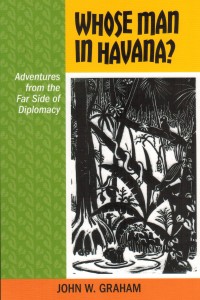Lost to history is the state funeral of Generalissimo Trujillo, strongman of the Dominican Republic, shot by assassins in 1961. Canadian diplomat John Graham attended the mass. “The only people in the entire church without guns were the clergy and the diplomatic corps,” he recalls.
Fearful that rebels would seize the corpse for public display, Trujillo’s henchmen hoisted it from the church by helicopter winch. “The Generalissimo’s coffin swinging in the air was a moment of unbearable, transcendent mystery for the dazed and credulous mourners below,” writes Graham. Only later did diplomats learn Trujillo wasn’t in the coffin. They’d stuffed it with an unknown corpse while preserving El Presidente in a freezer for quiet burial.
So goes Whose Man In Havana?, the memoirs of a man who served a lifetime in the foreign ministry. Graham’s writing is warm and personable with anecdotes from an era when Canada briefly walked on the world stage.
“When I first joined the foreign service in the late Fifties I caught the tail end of the much-ballyhooed Pearsonian golden age,” says Graham. “Although not always golden, it was a good time to be in External Affairs. The good times dipped a few times, but they did not come to an end with Mr. Pearson’s departure.”
Canada in the Fifties had a Nobel Peace Prize, the fourth largest air force on earth and an aircraft carrier, HMCS Magnificent. The British Empire was bankrupt, Europe was in ruins and America was desperate for Cold War friends. “In the post-war period, Canadians entered a time of prosperity that their forebears and indeed, most of the fellow inhabitants of the world had never dreamed of,” historian Craig Brown wrote in his 1987 Illustrated History of Canada.
Parliament thought nothing of buying Avro Arrow jets at $6.6 million a pop and driving defence spending to 40 percent of the federal budget. This was the heyday of Canadian diplomacy, Graham writes: “It is a term that invites abuse and is best avoided, but seen from the second decade of the twenty-first century, those years appear bathed in gilded light.”
It was an era when Canadian diplomats on the Latin beat packed pistols for safety. Graham recalls the assistant trade commissioner’s Chevrolet Impala was burned by Dominican street rioters in 1961. In Cuba, Graham spied for the CIA by sketching suspicious Soviet military installations: “When the mission was over I sometimes wondered whether I had reported anything significant in the acutely nervous Cold War context,” he writes. “I don’t know – Langley never told me – but I doubt it.”
Whose Man In Havana? is not a lament for a bygone era. It is a collection of reminiscences by a talented storyteller that leaves readers with indelible images like the massacre of black dogs in Haiti on rumours a Vodou spell had been cast over a corrupt local official named Duval. “A Priestess declared she had used her sacred Vodou powers to transform Duval into a dog, a black dog,” Graham explains; “The gardener told me no black dog is safe in all Port-au-Prince.”
By Holly Doan
Whose Man In Havana? Adventures from the Far Side of Diplomacy, by John W. Graham; University of Calgary Press; 328 pages; ISBN 9781-5523-8242; $34.95









